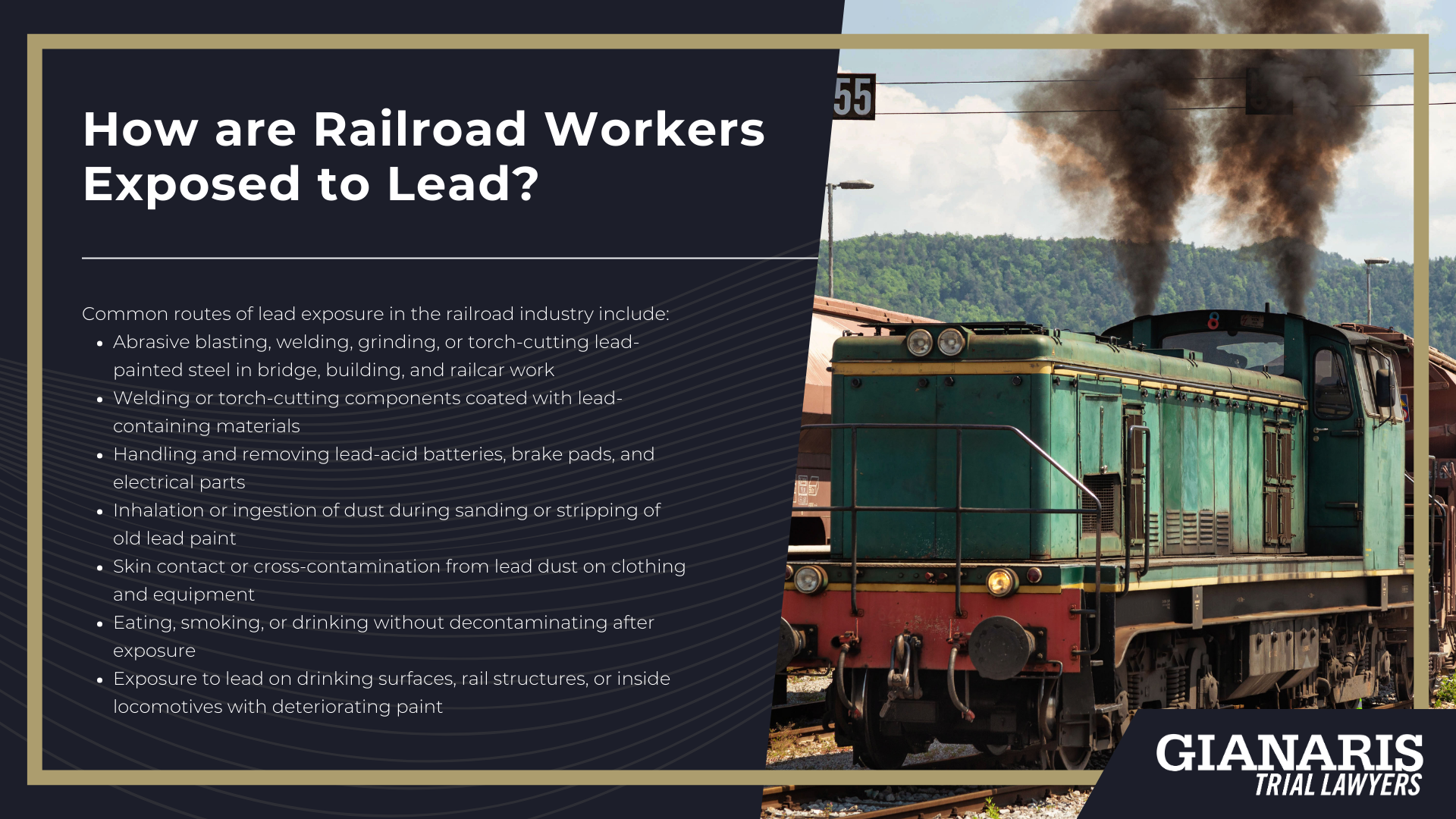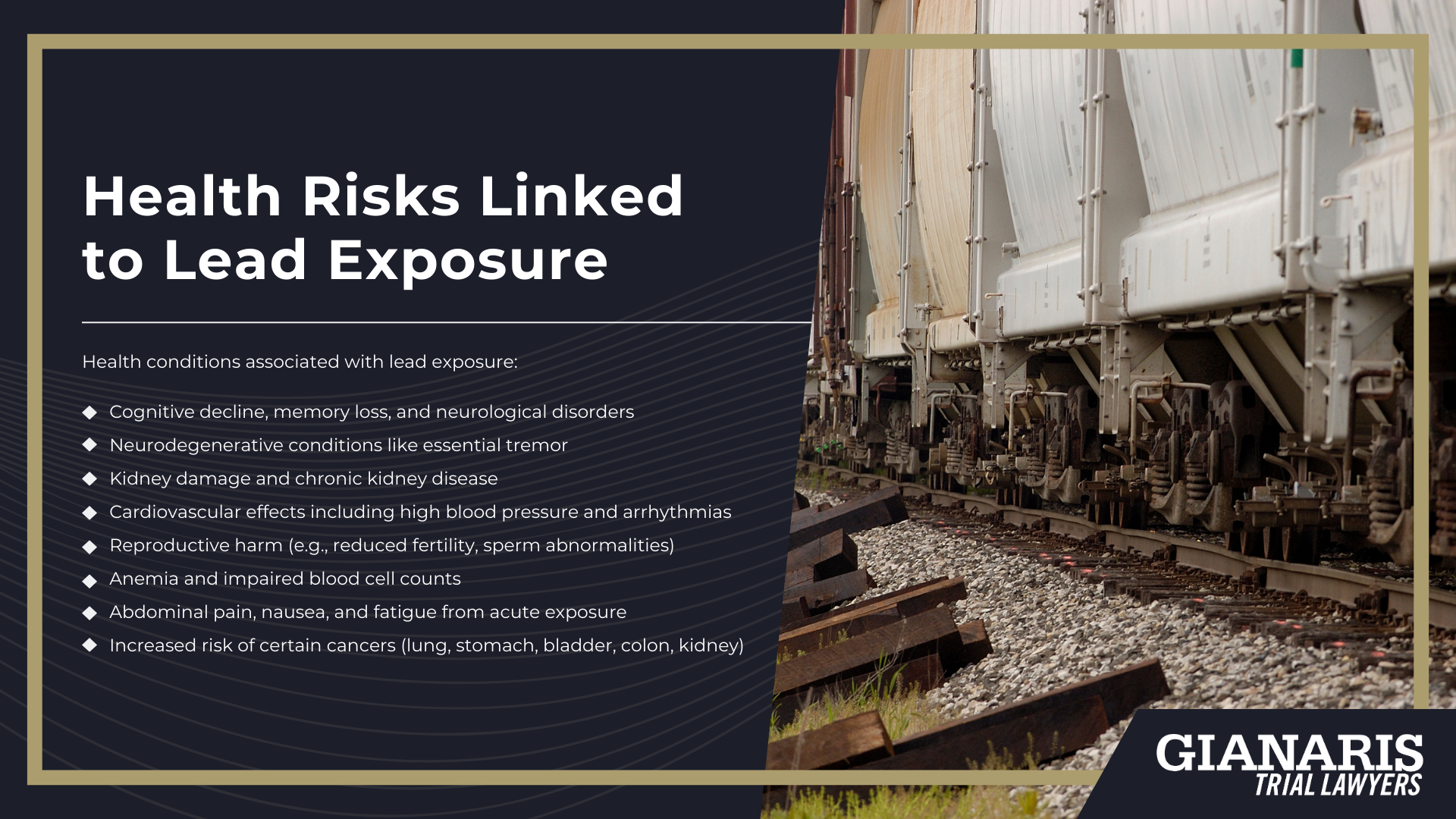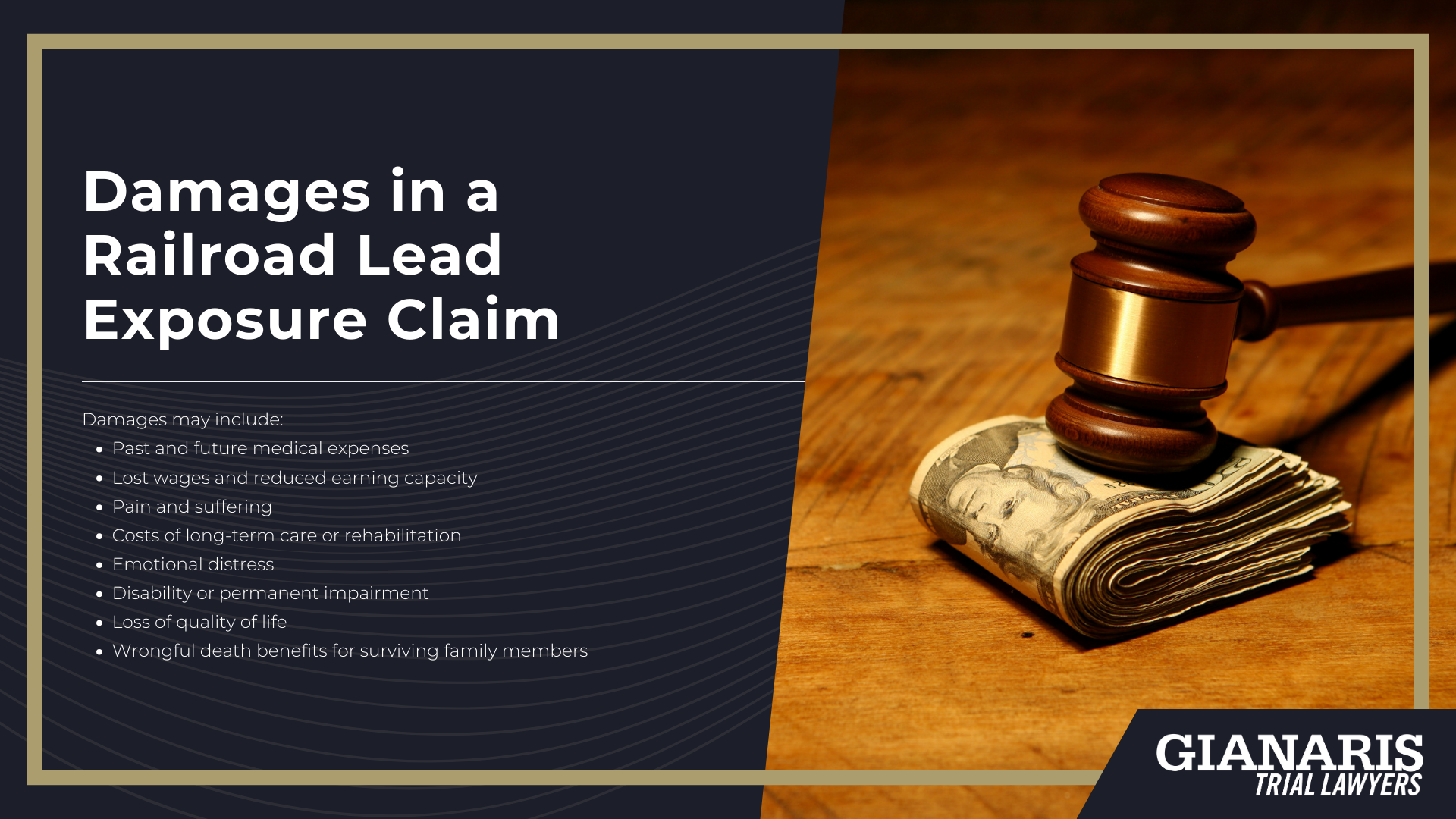Railroad employees across a wide range of job roles are frequently exposed to lead through routine maintenance, renovation, and demolition of aging infrastructure.
Lead is commonly found in old paint on bridges, railcars, structures, electrical components, and brake systems long used within the railroad industry.
Workers may also inhale lead dust generated by welding, torch cutting, abrasive blasting of lead‑based paint, or handling batteries and heavy-metal components in car shops.
These occupational exposures often go unchecked, as many railroad companies failed to warn workers or implement effective safety controls.
Lead particles can enter the body through inhalation or ingestion, especially when workers eat, drink, or smoke without first washing hands or changing contaminated clothing.
Even low-level lead exposure over time can lead to cognitive deficits, kidney damage, high blood pressure, reproductive harm, and permanent disability.
Acute or significant exposure can result in fatigue, abdominal pain, tremors, or anemia.
Lead often coexists with other dangerous substances such as diesel exhaust, crude oil, asbestos containing materials, welding fumes, benzene, and more in rail yards.
The risk is especially elevated for roles in bridges and buildings, car department shops, paint crews, maintenance teams, and signal or electrical workers who handle or disturb old lead-based coatings.

Common routes of lead exposure in the railroad industry include:
- Abrasive blasting, welding, grinding, or torch-cutting lead-painted steel in bridge, building, and railcar work
- Welding or torch-cutting components coated with lead-containing materials
- Handling and removing lead-acid batteries, brake pads, and electrical parts
- Inhalation or ingestion of dust during sanding or stripping of old lead paint
- Skin contact or cross-contamination from lead dust on clothing and equipment
- Eating, smoking, or drinking without decontaminating after exposure
- Exposure to lead on drinking surfaces, rail structures, or inside locomotives with deteriorating paint
Workers who develop serious symptoms or diagnoses linked to lead exposure (such as neurological impairment, kidney disease, reproductive issues, or high blood pressure) may qualify for legal action.
Under the Federal Employers Liability Act (FELA), affected railroad workers can pursue compensation if their employer was negligent in controlling workplace exposures and protecting their health.
Where is Lead Found in the Railroad Industry?
Lead is commonly found in a wide range of materials and components used throughout the railroad industry, especially in older infrastructure and equipment.
Railroad workers are often exposed when performing maintenance, repairs, or demolition on structures or systems containing lead-based products.
This exposure can occur in rail yards, shops, along track lines, or inside locomotives and train cars.
Jobs involving sanding, welding, cutting, or stripping paint increase the risk of disturbing and inhaling lead dust.
Lead may also be present in combination with other hazardous materials, compounding the health risks for workers.

Materials and locations where lead is found in the railroad industry:
- Lead-based paints on bridges, railcars, signal boxes, and locomotives
- Lead dust and paint chips from sanding or grinding metal surfaces
- Lead-containing electrical components, solder, and wiring insulation
- Brake pads and other friction materials in older trains
- Lead-acid batteries used in locomotives and maintenance equipment
- Steel structures in shops or yards coated with lead-based coatings
- Signal cabinets and junction boxes with leaded connectors or paint
- Infrastructure built before lead restrictions, including trestles and tunnels
Health Risks Linked to Lead Exposure
Lead exposure poses serious health risks for railroad workers, especially those involved in maintenance, welding, demolition, or repainting where lead-based materials are present.
According to the Agency for Toxic Substances and Disease Registry (ATSDR) and the World Health Organization, long-term exposure to lead can lead to systemic toxicity affecting the neurological, cardiovascular, renal, and reproductive systems.
While lead is classified as a probable human carcinogen by authorities like IARC and the National Toxicology Program, evidence of cancer risk remains limited and inconclusive, particularly for lung cancer and stomach cancer in occupational settings.
Railroad workers face disruption of normal red and white blood cell production after lead dust inhalation, leading to anemia, reduced immune function, and increased susceptibility to infection and fatigue.
Lead also impairs kidney function and can contribute to hypertension and heart disease over time.
Neurologically, chronic lead exposure has been linked to memory loss, essential tremor, mood changes, and early signs of cognitive decline.
Short-term or significant exposure may also cause nausea, abdominal pain, headaches, weakness, and chemical nausea or tremors.
Railroad workers exposed to lead in combination with other toxic substances (such as diesel exhaust, asbestos, welding fumes, benzene exposure, and more) may experience compounded harm from multiple occupational exposures.

Health conditions associated with lead exposure:
- Cognitive decline, memory loss, and neurological disorders
- Neurodegenerative conditions like essential tremor
- Kidney damage and chronic kidney disease
- Cardiovascular effects including high blood pressure and arrhythmias
- Reproductive harm (e.g., reduced fertility, sperm abnormalities)
- Anemia and impaired blood cell counts
- Abdominal pain, nausea, and fatigue from acute exposure
- Increased risk of certain cancers (lung, stomach, bladder, colon, kidney) — based on limited epidemiological evidence
Although associations between lead and cancer remain less definitive than in benzene or asbestos cases, railroad workers exposed to lead powder, dust, fumes, or paint over many years may face serious occupational illness with lasting impairments.
Under the Federal Employers Liability Act (FELA), affected workers may pursue legal claims for medical care, lost earnings, pain and suffering, and in some cases wrongful death, especially when their railroad employer failed to warn workers or control workplace exposures.
If you or a loved one have suffered symptoms or diagnoses related to lead exposure while working in the railroad industry, contact Gianaris Trial Lawyers for a free evaluation of your potential legal options.







